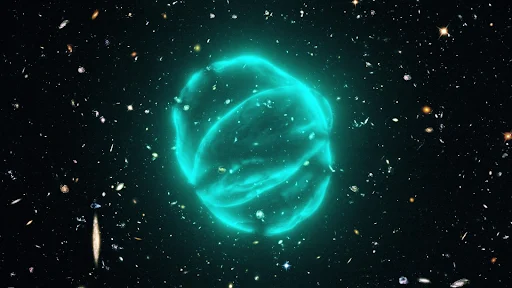The Mystery of Vast 'Cosmic ORCs' May Be Solved
For years, astronomers have been baffled by the existence of odd radio circles (ORCs). These enormous rings of radio emission, some over a million light-years across, can engulf entire galaxies. Unlike anything else seen in the universe, ORCs have remained a mystery, with theories about their origin ranging from shockwaves from supermassive black holes to the footprints of exotic new particles.
But now, a team of astronomers led by Professor Alison Coil of the University of California San Diego may have finally cracked the case. In a new study published in the journal Nature, they propose that ORCs are formed by powerful winds generated by bursts of supernovae.
"We think ORCs are like bubbles blown by the collective blast of dozens or even hundreds of supernovae," Coil said in a press release. "These supernovae would occur in a burst, triggered by a collision between two galaxies."
When galaxies collide, their gas clouds can be thrown into disarray, leading to a period of intense star formation. As these massive stars burn out and explode, they release huge amounts of energy and gas. This ejected material can then slam into surrounding gas, creating shockwaves that heat up the electrons in the interstellar medium and cause them to emit radio waves.
The team's theory is supported by observations of several ORCs, which show that they are indeed associated with galaxies that have undergone recent mergers. Additionally, the size and shape of ORCs are consistent with what would be expected from supernova-driven winds.
"This is a really exciting discovery," said study co-author Dr. Ryan Foley of the University of California Santa Cruz. "It provides a new window into the violent lives of galaxies and the powerful forces that shape them."
If the team's theory is correct, it could have significant implications for our understanding of galaxy evolution. ORCs could be used to trace the history of mergers between galaxies, and they could also provide clues about the formation of black holes.
"Ultimately, understanding ORCs could help us to better understand the universe as a whole," Coil said.
The discovery of the possible origin of ORCs is a major breakthrough in our understanding of these mysterious cosmic phenomena. It is a testament to the power of scientific observation and theoretical modeling, and it opens up new avenues for research into the formation and evolution of galaxies.
Additional points of interest:
- The first ORC was discovered in 2019 by astronomer Anna Kapinska using the Australian Square Kilometre Array Pathfinder (ASKAP) radio telescope.
- ORCs are so faint that they can only be seen in radio waves.
- There are only a handful of ORCs known to exist, but astronomers believe that there could be many more that have yet to be discovered.
I hope this article is helpful! Let me know if you have any other questions.
Tags
Space News
